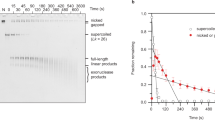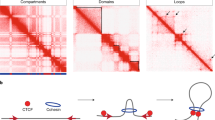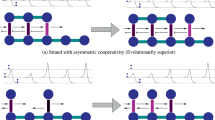Key Points
-
Five major ideas regarding the highly specialized proteins that move DNA are discussed in this review.
-
Proteins move DNA. A protein can be thought of as moving on DNA, or alternatively, DNA can be moving past the protein. Depending on what moves, the consequences are dramatically different. Movement of DNA within the cell has to be regulated and must be accurate with respect to cell division. This is one of a number of occasions that require the DNA to be moved, not the protein.
-
DNA movers are large. Many of the DNA-moving proteins have a total molecular mass of over a million Daltons, whereas more passive DNA-binding proteins are uniformly small. These enzymes are large because they need large surfaces to multimerize and interact with DNA, and because they are often composites of multiple activities.
-
Enzymes use energy to enforce reaction directionality. Nucleotide binding and release is often as important in luring enzymes into catalytically proficient states as ATP hydrolysis itself. DNA motors such as topoisomerases often employ the binding of ATP to produce specific structural changes in the enzyme that ensure reaction directionality. Topoisomerases use energy to reduce topological entanglements to sub-equilibrium levels.
-
Directed stochasticity. Counter-intuitively, DNA-moving enzymes often act stochastically rather than in a deterministic fashion. Their action at a given instant is not always in the direction of the overall process. The DNA translocase FtsK, DNA-replication forks and microtubule polymerization all have this property. The ability to 'capture' molecules that have successfully reached their precise location following movement presumably allowed this simple and robust strategy to arise several times throughout the course of evolution.
-
Moving DNA has topological consequences. A common but unexpected feature of all DNA translocases is that motion of the DNA leads to changes in its topology. They produce changes in twist (which is convertible to writhe), ahead of and behind the protein, that require removal by topoisomerases. Only recently have single-molecule biophysical techniques allowed these important changes to be measured.
Abstract
As genetic material DNA is wonderful, but as a macromolecule it is unruly, voluminous and fragile. Without the action of DNA replicases, topoisomerases, helicases, translocases and recombinases, the genome would collapse into a topologically entangled random coil that would be useless to the cell. We discuss the organization, movement and energetics of these proteins that are crucial to the preservation of a molecule that has such beautiful biological but challenging physical properties.
This is a preview of subscription content, access via your institution
Access options
Subscribe to this journal
Receive 12 print issues and online access
$189.00 per year
only $15.75 per issue
Buy this article
- Purchase on Springer Link
- Instant access to full article PDF
Prices may be subject to local taxes which are calculated during checkout



Similar content being viewed by others
References
Holmes, V. F. & Cozzarelli, N. R. Closing the ring: links between SMC proteins and chromosome partitioning, condensation, and supercoiling. Proc. Natl Acad. Sci. USA 97, 1322–1324 (2000).
Hardy, C. D. & Cozzarelli, N. R. A genetic selection for supercoiling mutants of Escherichia coli reveals proteins implicated in chromosome structure. Mol. Microbiol. 57, 1636–1652 (2005).
Wang, J. C. DNA topoisomerases. Annu. Rev. Biochem. 65, 635–692 (1996).
Wang, J. C. Cellular roles of DNA topoisomerases: a molecular perspective. Nature Rev. Mol. Cell Biol. 3, 430–440 (2002).
Bejerano-Sagie, M. et al. A checkpoint protein that scans the chromosome for damage at the start of sporulation in Bacillus subtilis. Cell 125, 679–690 (2006).
Gowers, D. M., Wilson, G. G. & Halford, S. E. Measurement of the contributions of 1D and 3D pathways to the translocation of a protein along DNA. Proc. Natl Acad. Sci. USA 102, 15883–15888 (2005). Sequence-specific binding proteins have optimized the time that is required to find their site by using a combination of translocation along DNA and cycles of disassociation, diffusion and reassociation.
Wu, L. J. & Errington, J. Septal localization of the SpoIIIE chromosome partitioning protein in Bacillus subtilis. EMBO J. 16, 2161–2169 (1997).
Yu, X. C., Tran, A. H., Sun, Q. & Margolin, W. Localization of cell division protein FtsK to the Escherichia coli septum and identification of a potential N-terminal targeting domain. J. Bacteriol. 180, 1296–1304 (1998).
Ben-Yehuda, S., Rudner, D. Z. & Losick, R. Assembly of the SpoIIIE DNA translocase depends on chromosome trapping in Bacillus subtilis. Curr. Biol. 13, 2196–2200 (2003).
Bath, J., Wu, L. J., Errington, J. & Wang, J. C. Role of Bacillus subtilis SpoIIIE in DNA transport across the mother cell-prespore division septum. Science 290, 995–997 (2000).
Liu, G., Draper, G. C. & Donachie, W. D. FtsK is a bifunctional protein involved in cell division and chromosome localization in Escherichia coli. Mol. Microbiol. 29, 893–903 (1998).
Capiaux, H., Lesterlin, C., Perals, K., Louarn, J. M. & Cornet, F. A dual role for the FtsK protein in Escherichia coli chromosome segregation. EMBO Rep. 3, 532–536 (2002).
Massey, T. H., Aussel, L., Barre, F. X. & Sherratt, D. J. Asymmetric activation of Xer site-specific recombination by FtsK. EMBO Rep. 5, 399–404 (2004).
Sharp, M. D. & Pogliano, K. Role of cell-specific SpoIIIE assembly in polarity of DNA transfer. Science 295, 137–139 (2002).
Gelles, J. & Landick, R. RNA polymerase as a molecular motor. Cell 93, 13–16 (1998). This paper changed the way we think about protein–DNA translocation by demonstrating that a stationary RNA polymerase can move large pieces of DNA.
Lewis, P. J., Thaker, S. D. & Errington, J. Compartmentalization of transcription and translation in Bacillus subtilis. EMBO J. 19, 710–718 (2000).
Cabrera, J. E. & Jin, D. J. The distribution of RNA polymerase in Escherichia coli is dynamic and sensitive to environmental cues. Mol. Microbiol. 50, 1493–1505 (2003).
Dworkin, J. & Losick, R. Does RNA polymerase help drive chromosome segregation in bacteria? Proc. Natl Acad. Sci. USA 99, 14089–14094 (2002).
Jensen, R. B., Wang, S. C. & Shapiro, L. A moving DNA replication factory in Caulobacter crescentus. EMBO J. 20, 4952–4963 (2001).
Lau, I. F. et al. Spatial and temporal organization of replicating Escherichia coli chromosomes. Mol. Microbiol. 49, 731–743 (2003).
Pages, V. & Fuchs, R. P. Uncoupling of leading- and lagging-strand DNA replication during lesion bypass in vivo. Science 300, 1300–1303 (2003).
Lemon, K. P. & Grossman, A. D. Movement of replicating DNA through a stationary replisome. Mol. Cell 6, 1321–1330 (2000). Introduced the factory model of DNA replication according to which DNA moves far more through a replication factory than the factory moves within the cell.
Cook, P. R. The organization of replication and transcription. Science 284, 1790–1795 (1999).
Skoko, D., Yan, J., Johnson, R. C., Marko, J. F. Low-force DNA condensation and discontinuous high-force decondensation reveal a loop-stabilizing function of the protein Fis. Phys. Rev. Lett. 95, 208101 (2005).
Rimsky, S. Structure of the histone-like protein H-NS and its role in regulation and genome superstructure. Curr. Opin. Microbiol. 7, 109–114 (2004).
Dame, R. T., Wyman, C. & Goosen, N. H-NS mediated compaction of DNA visualised by atomic force microscopy. Nucleic Acids Res. 28, 3504–3510 (2000).
Schneider, R. et al. An architectural role of the Escherichia coli chromatin protein FIS in organising DNA. Nucleic Acids Res. 29, 5107–5114 (2001).
Johnson, A. & O'Donnell, M. Cellular DNA replicases: components and dynamics at the replication fork. Annu. Rev. Biochem. 74, 283–315 (2005).
Schrödinger, E. What is Life? (Cambridge University Press, Cambridge, 1944).
Jenks, W. P. Binding energy, and enzymic catalysis: the circe effect. Adv. Enzymol. Relat. Areas Mol. Biol. 43, 219–410 (1975).
Champoux, J. J. DNA topoisomerases: structure, function, and mechanism. Annu. Rev. Biochem. 70, 369–413 (2001).
Brown, P. O. & Cozzarelli, N. R. A sign inversion mechanism for enzymatic supercoiling of DNA. Science 206, 1081–1083 (1979).
Harkins, T. T., Lewis, T. J. & Lindsley, J. E. Pre-steady-state analysis of ATP hydrolysis by Saccharomyces cerevisiae DNA topoisomerase II. 2. Kinetic mechanism for the sequential hydrolysis of two ATP. Biochemistry 37, 7299–7312 (1998).
Crisona, N. J., Strick, T. R., Bensimon, D., Croquette, V. & Cozzarelli, N. R. Preferential relaxation of positively supercoiled DNA by E. coli topoisomerase IV in single-molecule and ensemble measurements. Genes Dev. 14, 2881–2892 (2000).
Stone, M. D. et al. Chirality sensing by Escherichia coli topoisomerase IV and the mechanism of type II topoisomerases. Proc. Natl Acad. Sci. USA 100, 8654–8659 (2003).
Wilcox, K. W. & Smith, H. O. Mechanism of DNA degradation by the ATP-dependent DNase from Hemophilus influenzae Rd. J. Biol. Chem. 251, 6127–6134 (1976).
Rybenkov, V. V., Ullsperger, C., Vologodskii, A. V. & Cozzarelli, N. R. Simplification of DNA topology below equilibrium values by type II topoisomerases. Science 277, 690–693 (1997).
Worcel, A. & Burgi, E. On the structure of the folded chromosome of Escherichia coli. J. Mol. Biol. 71, 127–147 (1972).
Sundin, O. & Varshavsky, A. Arrest of segregation leads to accumulation of highly intertwined catenated dimers: dissection of the final stages of SV40 DNA replication. Cell 25, 659–669 (1981).
Blakely, G. et al. Two related recombinases are required for site-specific recombination at dif and cer in E. coli K12. Cell 75, 351–361 (1993).
Saleh, O. A., Bigot, S., Barre, F. X. & Allemand, J. F. Analysis of DNA supercoil induction by FtsK indicates translocation without groove-tracking. Nature Struct. Mol. Biol. 12, 436–440 (2005).
Pease, P. J. et al. Sequence-directed DNA translocation by purified FtsK. Science 307, 586–90 (2005). A demonstration that the DNA sequence of the E. coli chromosome reverses FtsK translocation to allow it to find the dif site efficiently.
Levy, O. et al. Identification of oligonucleotide sequences that direct the movement of the Escherichia coli FtsK translocase. Proc. Natl Acad. Sci. USA 102, 17618–17623 (2005).
Bigot, S. et al. KOPS: DNA motifs that control E. coli chromosome segregation by orienting the FtsK translocase. EMBO J. 24, 3770–3780 (2005).
Martin, A., Baker, T. A. & Sauer, R. T. Rebuilt AAA+ motors reveal operating principles for ATP-fuelled machines. Nature 437, 1115–1120 (2005). An elegant dissection of the AAA+ hexamer showed that the ATPase activity within a hexamer is random.
Kline-Smith, S. L. & Walczak, C. E. Mitotic spindle assembly and chromosome segregation: refocusing on microtubule dynamics. Mol. Cell 15, 317–327 (2004).
Mitchison, T. & Kirschner, M. Dynamic instability of microtubule growth. Nature 312, 237–242 (1984).
Breier, A. M., Weier, H. U. & Cozzarelli, N. R. Independence of replisomes in Escherichia coli chromosomal replication. Proc. Natl Acad. Sci. USA 102, 3942–3947 (2005).
Dressler, D., Wolfson, J. & Magazin, M. Initiation and reinitiation of DNA synthesis during replication of bacteriophage T7. Proc. Natl Acad. Sci. USA 69, 998–1002 (1972).
Higgins, N. P., Kato, K. & Strauss, B. A model for replication repair in mammalian cells. J. Mol. Biol. 101, 417–425 (1976).
Postow, L. et al. Positive torsional strain causes the formation of a four-way junction at replication forks. J. Biol. Chem. 276, 2790–2796 (2001).
Bryant, Z. et al. Structural transitions and elasticity from torque measurements on DNA. Nature 424, 338–341 (2003).
Gore, J. et al. Mechanochemical analysis of DNA gyrase using rotor bead tracking. Nature 439, 100–104 (2006).
White, J. H. Self-linking and the Gauss integral in higher dimensions. Am. J. Math. 91, 693–728 (1969).
Calugareanu, G. Sur les classes d'isotopie des noeuds tridimensionnels et leurs invariants. Czech Math. J. 11, 588–625 (1961).
Cozzarelli, N. R. & Wang, J. C. (eds) DNA Topology and its Biological Effects (Cold Spring Harbor Laboratory Press, Cold Spring Harbor, 1990).
Liu, L. F. & Wang, J. C. Supercoiling of the DNA template during transcription. Proc. Natl Acad. Sci. USA 84, 7024–7027 (1987).
Harada, Y. et al. Direct observation of DNA rotation during transcription by Escherichia coli RNA polymerase. Nature 409, 113–115 (2001). One of the first direct measurements of DNA twist.
Schafer, D. A., Gelles, J., Sheetz, M. P. & Landick, R. Transcription by single molecules of RNA polymerase observed by light microscopy. Nature 352, 444–448 (1991).
Wuite, G. J., Smith, S. B., Young, M., Keller, D. & Bustamante, C. Single-molecule studies of the effect of template tension on T7 DNA polymerase activity. Nature 404, 103–106 (2000).
Lia, G. et al. Direct observation of DNA distortion by the RSC complex. Mol. Cell 21, 417–425 (2006).
Auble, D. T. et al. Mot1, a global repressor of RNA polymerase II transcription, inhibits TBP binding to DNA by an ATP-dependent mechanism. Genes Dev. 8, 1920–1934 (1994).
Eisen, J. A., Sweder, K. S. & Hanawalt, P. C. Evolution of the SNF2 family of proteins: subfamilies with distinct sequences and functions. Nucleic Acids Res. 23, 2715–2723 (1995).
Mazin, A. V., Alexeev, A. A. & Kowalczykowski, S. C. A novel function of Rad54 protein. Stabilization of the Rad51 nucleoprotein filament. J. Biol. Chem. 278, 14029–14036 (2003).
Lee, D. G. & Bell, S. P. ATPase switches controlling DNA replication initiation. Curr. Opin. Cell Biol. 12, 280–285 (2000).
Tye, B. K. MCM proteins in DNA replication. Annu. Rev. Biochem. 68, 649–686 (1999).
Marston, A. L. & Errington, J. Dynamic movement of the ParA-like Soj protein of B. subtilis and its dual role in nucleoid organization and developmental regulation. Mol. Cell 4, 673–682 (1999).
Quisel, J. D. & Grossman, A. D. Control of sporulation gene expression in Bacillus subtilis by the chromosome partitioning proteins Soj (ParA) and Spo0J (ParB). J. Bacteriol. 182, 3446–3451 (2000).
Sullivan, S. M. & Maddock, J. R. Bacterial sporulation: pole-to-pole protein oscillation. Curr. Biol. 10, R159–R161 (2000).
Cai, L., Friedman, N. & Xie, X. S. Stochastic protein expression in individual cells at the single molecule level. Nature 440, 358–362 (2006).
Lakadamyali, M., Rust, M. J. & Zhuang, X. Ligands for clathrin-mediated endocytosis are differentially sorted into distinct populations of early endosomes. Cell 124, 997–1009 (2006).
Yu, J., Xiao, J., Ren, X., Lao, K. & Xie, X. S. Probing gene expression in live cells, one protein molecule at a time. Science 311, 1600–1603 (2006).
Seidel, R. et al. Real-time observation of DNA translocation by the type I restriction modification enzyme EcoR124I. Nature Struct. Mol. Biol. 11, 838–843 (2004).
Morris, S. K. & Lindsley, J. E. Yeast topoisomerase II is inhibited by etoposide after hydrolyzing the first ATP and before releasing the second ADP. J. Biol. Chem. 274, 30690–30696 (1999).
Orphanides, G. & Maxwell, A. Evidence for a conformational change in the DNA gyrase-DNA complex from hydroxyl radical footprinting. Nucleic Acids Res. 22, 1567–1575 (1994).
Acknowledgements
The authors would like to dedicate this work to our friend and colleague N. Cozzarelli, who passed away during the completion of this review. We acknowledge N. Crisona for critical reading of this manuscript. Work in our laboratories was supported by the National Institutes of Health (N.R.C. and T.V.), Ruth Kirschtein awards (J.S. and G.C.) and the Human Frontiers Science Organization (M.N.).
Author information
Authors and Affiliations
Corresponding author
Ethics declarations
Competing interests
The authors declare no competing financial interests.
Glossary
- DNA motors
-
DNA-binding enzymes that use energy to move a segment of DNA processively from one point to another or to track along DNA.
- Septum
-
The protein ring at the mid-point of a bacterial cell that demarcates the site of future cell division.
- Replisome
-
A multiprotein complex that is involved in DNA replication.
- Ground state/transition state
-
The most stable/least stable (lowest-energy/highest-energy) state of a chemical reaction.
- B-form DNA
-
A right-handed double-helical conformation of DNA that is the most common form seen in solution.
- Decatenase/catenase
-
An enzyme that removes/adds catenanes.
- Endergonic reaction
-
A reaction that consumes or traps energy.
- Exergonic reaction
-
A reaction that produces or releases energy.
- Catenane
-
A topologically linked circular molecule.
- dif
-
A 28-nucleotide sequence near the terminus of DNA replication in E. coli that is the recognition site for the XerC and XerD recombinases.
- AAA+ family of ATPases
-
(ATPases with associated activities). A large family of ATP hydrolases that is typified by a highly conserved catalytic motif. The members of the family greatly vary in both form and function.
- Kinetochore
-
A large multiprotein complex that assembles onto the centromere of the chromosome and links the chromosome to the microtubules of the mitotic spindle.
- Protomer
-
Any of the subunits of which an oligomeric protein is built up.
Rights and permissions
About this article
Cite this article
Cozzarelli, N., Cost, G., Nöllmann, M. et al. Giant proteins that move DNA: bullies of the genomic playground. Nat Rev Mol Cell Biol 7, 580–588 (2006). https://doi.org/10.1038/nrm1982
Issue Date:
DOI: https://doi.org/10.1038/nrm1982
This article is cited by
-
DNA torsional stress propagates through chromatin fiber and participates in transcriptional regulation
Nature Structural & Molecular Biology (2008)
-
Hin-mediated DNA knotting and recombining promote replicon dysfunction and mutation
BMC Molecular Biology (2007)



